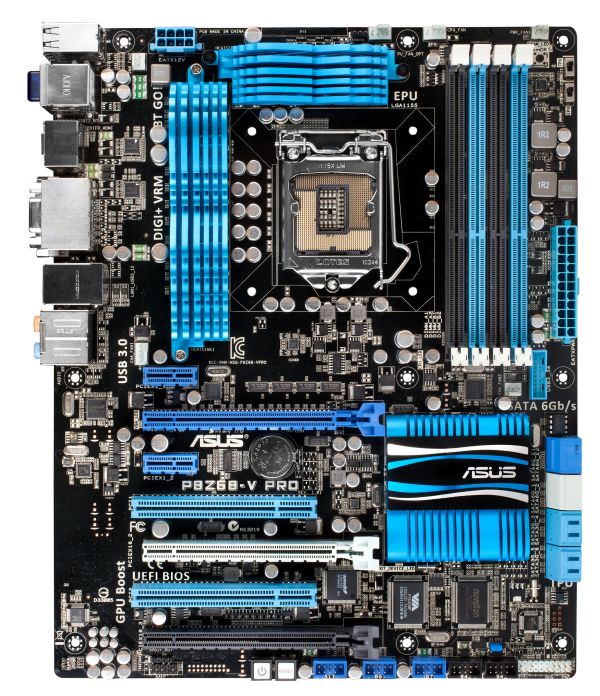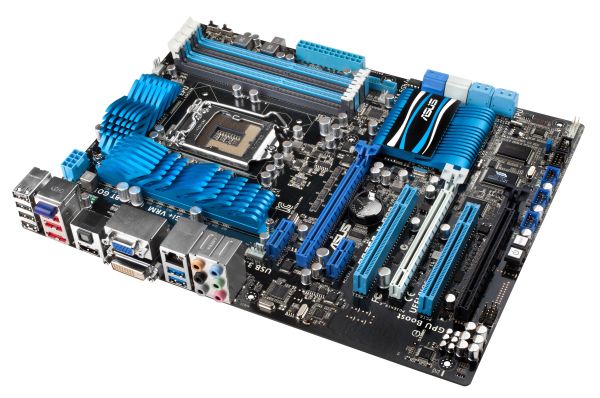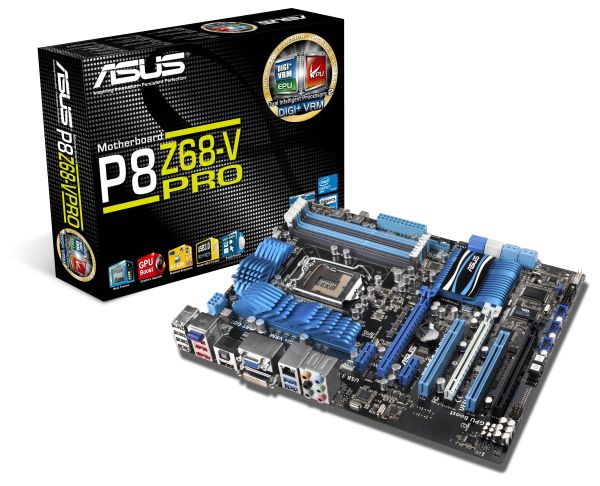ASUS P8Z68-V PRO Review: Our First Z68 Motherboard
by Ian Cutress on May 11, 2011 3:13 AM EST- Posted in
- Motherboards
- Asus
- Z68
ASUS P8Z68-V PRO: Overview
This board from ASUS is a great all-round performer, compared to the P67 boards we have reviewed—space for tri-GPU setups, six fan headers with good OS fan controls, eight SATA ports, six with RAID 0/1/5/10, Intel gigabit Ethernet and it performs well in our benchmark suite. The goods bundled in the box aren't the best we've seen, especially for an expected retail price of $210. But this is a Z68 board—the seemingly logical progression Intel have taken to combine the best bits of P67 and H67, in terms of overclocking. It's thanks to software solutions such as LUCIDLOGIX's Virtu that we can harness both the integrated GPU and discrete GPUs for different work loads—I detail my experiences with Virtu in this review.
ASUS P8Z68-V PRO: Visual Inspection
A quick look at the P8Z67-V PRO board and you might be joining me in thinking it looks almost identical to the P8P67 PRO motherboard. The blue, black and grey livery is still here, with those blue wavy heatsinks covering up the 12 phase CPU and 4 phase iGPU power delivery—unlike other boards, these aren't joined by a heatpipe, and the larger heatsink has a pretty substantial plate connecting the ends on the back of the board.
Around the socket itself, there is one 4-pin chassis fan header near the PCIe 1x, one PWR 3-pin near the 12V CPU power connector, and two CPU fan headers (one 4-pin, one 3-pin) to the top right, which should cover any all-in-one cooling solution with a dual fan and water pump arrangement. Unlike some other Cougar Point motherboards, ASUS have located the PCH to below the DIMM slots, under a large flat heatsink which gets quite warm to touch under normal operation.
Alongside the DIMM slots we have another 3-pin PWR fan header in the top right, just above ASUS' EPU and TPU switches, which activate their Energy Processing Unit and TurboV Processing Units respectively, for lower power usage or automatic overclocking. Enabling both could lead to system instability, however. Underneath these, beyond the 24-pin ATX power connector is a a 3-pin chassis fan header and the USB 3.0 19-pin header. As this is placed here, you would assume ASUS are thinking everyone will be using this header to power a USB 3.0 bracket in the front of the case, rather than the rear. But the supplied USB 3.0 bracket is designed for the rear of the board and doesn't stretch that far, especially over a dual slot GPU should one be in use.
The SATA ports are similar to that found on the P8P67 Pro—the four SATA 3 Gbps from the PCH are in blue, the two SATA 6 Gbps from the PCH are in white, and two SATA 6 Gbps from a Marvell controller. Rather than place the Power/Reset buttons underneath the SATA ports, they are found amongst the myriad of USB and IEEE 1394 headers along the bottom of the board, making them very inconvenient if all three full-size PCIe slots are occupied with dual slot cards.
The PCIe slot arrangement is standard—enough space at the top for a full length PCIe x1 card, with a PCIe x16 slot underneath with a triple slot gap to the next PCIe x16. The three full length PCIe slots run in x16/x0/x4 or x8/x8/x4 mode for GPU setups. However, the bottom PCIe slot shares bandwidth PCIe x1 slots, a two USB ports in the IO panel and the eSATA IO port—all of these are inactive if the bottom PCIe is in x4 mode. By default, the PCIe is in x1 mode, and requires a BIOS setting change for x4.
The IO panel for Z68 boards supporting integrated graphics is a combined mix of previous P67 and H67 iterations, and as such we either lose legacy connections or USB ports infavor of video out ports. There's no PS/2 legacy connector—instead we have on the far left four USB 2.0 ports, then another two USB 2.0 ports, the eSATA 3 Gbps port powered by a JMicron JMB362 controller, and a Bluetooth module. These red USB 2.0 ports/eSATA port are the ones disabled when the third PCIe is in x4 mode. In terms of video outputs, we have a HDMI, DVI and VGA—no display port here, instead you get an optical S/PDIF out (which also means no coaxial S/PDIF out). Just a single gigabit Ethernet port powered by an Intel 82579, and a pair of USB 3.0 ports powered by ASMedia controller. Standard Realtek ALC892 8-channel audio is also present.














95 Comments
View All Comments
L. - Thursday, May 12, 2011 - link
What you are searching for is not undervolting and underclocking, its called advanced, manually-defined "speedstep".Haven't heard of it available commercially but some guy did that for his old AMD XP and it was pretty interesting - although that chip slowed down to almost a standstill on the lowest setting.
Sunsmasher - Wednesday, May 11, 2011 - link
A board that performs well under the higher stresses of overclocking/overvolting will of course perform well in an undervolting situation. It's then up to the user (you) to find undervolting settings that work well with your particular processor.Also, it would be silly to buy a motherboard in this class (3 gpu capable, etc.), if your intention were to save as much power in your system as possible. An H67 board would probably make more sense for an undervolted "green' system. Most Anandtech readers who read reviews of boards in this class are, I sure, interested in the maximum performance available in their systems as opposed to saving energy. (Saving energy is an admirable goal, of course, just not the main priority of people who want maximum possible performance.) That's why undervolting testing is not done here, I'm sure.
gevorg - Wednesday, May 11, 2011 - link
Good point! Even when you seek high performance, low power and energy saving are still very important because your might leave your computer idle or use it for simple tasks, and its important for it to dynamically change to your needs without being an energy hog when it doesn't need to be.tomoyo - Wednesday, May 11, 2011 - link
I'd just be happy with the following data on each motherboard to make sure you have something low power and silent:1) What voltage selections you have for both under and overvolting
2) What fan speed choices you can choose.
3) What the power consumption with said motherboard is compared to similar ones at idle and load.
(It seems intel generally wins in this category at idle)
This will make it clear if you have something that is a champ for low power.
Rajinder Gill - Thursday, May 12, 2011 - link
Looking at the core voltage scale in the spec table in the article - it starts at 0.8V and also that you've got multiplier control. That means underclocking is possible.One thing that many of you are probably aware of (but some aren't) is that if you have C1E and SpeedStep active, light loading power savings due to reduced VID are so small that it's hard to measure them - certainly not with a standard plug-in AC level meter. The measurements need to be done at DC and may show that some of the potential savings may be nullified by the VRM efficiency curve if some form of load dependant phase control isn't supported by the system.
As for full loading scenarios, you can set the idle threshold percentage in Windows 7 to a higher level, thus ensuring the processor only goes into full load state under the most arduous loads. This way you get to keep the performance advantage of a higher clock freqeuncy (if and where needed), while still having the ultra low consumption courtesy of power gating through all major sections of the processor including cache (in C6 state).
In truth, to educate the masses, this properly this probably needs a separate article and followed up by a two line blurb when reviewing a motherboard to state whether the BIOS allows underclocking. That's about all there is to it in my opinion, I don't think too much time needs to be spent on the subject in subsequent reviews with the groundwork out of the way.
Regards
NeBlackCat - Friday, May 13, 2011 - link
Great post, thanks for that information.Sabresiberian - Friday, May 13, 2011 - link
Frankly, I want a high end mainboard to have no expense allocated for audio at all; I'll buy a decent solution for my sound thank you very much, please save me a few bucks to put toward that end! Or, put the money into figuring out how I can add a sound card AND have triple SLI/Crossfire. Build in a Killer NIC so I don't have to use an addon card there.Mid and low-end cards should have mid or low-end sound solutions.
;)
xinaes - Wednesday, May 11, 2011 - link
"graphics card manufacturers are pretty good on low power states"... unless you connect more than one display, in which case they apparently push cards into 3d clock speeds constantly:http://www.silentpcreview.com/forums/viewtopic.php...
I'd like to know if boards such as this will let me run two displays off the IGP with Virtu in i-mode, how much power that would consume, also what the hit would be on performance under different circumstances. I'm hopeful that the IGP might be able to drive both displays without using substantial amounts of power for basic tasks, and that the performance cost in more demanding situations while appreciable would not be crippling.
Krenn - Wednesday, May 11, 2011 - link
That's an excellent question - I'd love to see the same thing. I usually use two monitors for basic tasks and only one for gaming, but would like to save power without having to unplug & switch the monitor cables. Also, I had no idea running two monitors from the same video card was using more power than it should; that could definitely make a difference.I assume you can't mix and match and connect one monitor to the integrated and the other to the discrete and use both monitors at the same time.
xinaes - Wednesday, May 11, 2011 - link
I'm not sure exactly what mixing and matching is possible. Something that was posited as a workaround in the thread I linked (in the context of systems where IGP is not available) is using a second low power GPU to drive the secondary display. It may well be that the IGP could fill a similar role with a Z68 board, but it's hard to be sure.For me it would be irritating as I don't only use the graphics for gaming on a single screen; I'd want at times to run 3d apps with resources shared by windows on both screens etc. Still, I'd like to at least have the option of such a workaround if it meant saving power, even if it was irritating in certain circumstances.